A Narrative Review of Childhood Picky Eating and Its Relationship to Food Intakes, Nutritional Status, and Growth
Picky eating, which is also referred to as fussy eating, selective eating, faddy eating, and choosy eating, is a complex behavior that broadly refers to a combination of traits. As children start complementary feeding and become exposed to an increasingly diversified diet, many begin to exhibit “picky eating” behaviors. The main characteristic of children perceived as picky eaters is their tendency to avoid certain foods or food groups. The goal of this review is to provide an overview of published studies that have examined whether picky eating in childhood is in fact associated with measurable differences in food and/or nutrient intakes and growth.
A Narrative Review of Childhood Picky Eating and Its Relationship to Food Intakes, Nutritional Status, and Growth
Tinu Mary Samuel, Kathy Musa-Veloso, Manki Ho, Carolina Venditti and Yassaman Shahkhalili-Dulloo
Keywords
Picky eating, food intake, diet, macronutrient, micronutrient, growth, children
Abstract
A main characteristic of children perceived as picky eaters is their tendency to avoid certain foods or food groups. The goal of this narrative review is to provide an overview of published studies that have examined whether picky eating in childhood is in fact associated with measurable differences in food and/or nutrient intakes and growth. While picky eaters appear to consume less vegetables compared to non-picky eaters, no consistent differences were observed for the intakes of other food groups or the intakes of energy, macronutrients and dietary fiber. Although, in some studies, picky eaters had lower intakes of certain vitamins and minerals, the levels consumed generally exceeded the recommended values, suggesting nutritional requirements are being met. No consistent relationship between childhood picky eating and growth status was observed, although significant differences in body weight/growth between picky and non-picky eaters were most discernible in studies where multiple defining criteria were used to identify picky eating. The research area would benefit from the adoption of a uniform definition of picky eating. More longitudinal assessments are also required to understand the long-term impact of picky eating on nutritional status and growth.
Introduction
Picky eating, which is also referred to as fussy eating, selective eating, faddy eating, and choosy eating, is a complex behavior that broadly refers to a combination of traits. As children start complementary feeding and become exposed to an increasingly diversified diet, many begin to exhibit “picky eating” behaviors. Currently, there is no concise definition for picky eating that has been widely adopted in the literature. Instead, as noted by Jacobi et al. [1], picky eating has been described as “more of an umbrella term for a spectrum of characteristics perceived by a caretaker or researcher”.
Some of the common behavioral traits that have been used to characterize picky eating include food selectivity (i.e., avoiding the intake of certain foods or food groups), sensory-sensitivity (i.e., avoidance of a food based on its sensory properties, or requiring the preparation or presentation of meals in a very particular way) and lack of interest in eating (i.e., eats only small amounts of food, has a poor appetite, eats slowly) [1–8]. For instance, when asked to openly describe their child’s eating behaviors, many parents of children perceived to be picky eaters reported that they tend to prefer eating foods predominantly from one food group (e.g., “breads only” or “fruits only”), or to avoid certain food groups altogether (e.g., vegetables) [3,4,9]. Picky eaters may also eat only a limited number of items from each food group (e.g., “eats only cereal or waffles from the bread group”, or “chicken nuggets only from the meat group”, or “won’t eat any meat except turkey”) [3,4,9]. Additionally, parents of picky eaters are more likely to report that their child does not consume an adequate amount of food at each meal [4,8], or that the child does not eat the amount of food that the parent thinks they should be eating [3,9]. In some cases, children who are viewed as picky eaters may also exhibit food neophobia (i.e., an unwillingness to try new and unfamiliar foods) [3,4].
It is well recognized that a nutritionally-balanced diet is critical for ensuring normal growth and development in children. Current dietary guidelines for children promote the intake of a varied diet filled with healthy, nutrient-dense foods, comprising a wide range of vegetables and fruits, cereals (preferably whole grains), lean proteins, and low-fat dairy products [10,11]. Foods that are high in saturated fat, added sugars, and added salt, which could displace the intake of healthier alternatives, should be limited [10,11]. These dietary recommendations help to ensure the adequate intake of nutrients that are considered necessary for the proper growth and development of children. The variety of foods consumed is also important, given that individual foods within each food group can differ with respect to their nutritional profiles. For example, within the protein group, poultry and meats provide rich sources of niacin and zinc, while seafoods are rich in omega-3 long-chain polyunsaturated fatty acids, eicosapentaenoic acid and docosahexaenoic acid [10]. Meat, poultry and seafoods are also sources of heme iron, which is more bioavailable than the non-heme iron present in plant proteins [10].
Even though picky eating is often viewed as a common and normal part of a child’s growth and development (i.e., from the time solid foods are introduced to early childhood), such selective eating behaviors may lead to a limited intake of certain foods or food groups, and accordingly, of key nutrients. In some children, it is possible that such disturbances in eating behaviors may result in a failure to meet adequate nutritional and/or energy needs, which could have serious and negative implications on health (e.g., growth impediment, nutritional deficiency, or other functional impairments). Indeed, for a parent or caregiver, the picky eating behaviors of the child can be quite worrisome. It is important to understand whether perceptions of picky eating are indeed associated with reduced diet variety and nutrient intakes, and if these, in turn, have any implications on the child’s nutritional status and growth.
Despite the lack of a “gold-standard” definition or tool available for identifying picky eaters, many studies have been published in recent years on the subject. These include studies that assessed whether picky eating, which is often perceived by the parent or caregiver based on their child’s selective eating behaviors and limited food choices, is, in fact, consistently associated with measurable differences in food intake.
In this narrative review, studies that assessed the food preferences and/or intakes of energy, macronutrients, and micronutrients of children perceived as picky eaters (e.g., as collected through food records), or measures of growth, are presented to better understand the nutritional and clinical consequences of picky eating among children.
Methods
A search of the scientific literature was conducted to identify pertinent publications on picky eating in children that were full-length peer-reviewed studies, published between 1 January 1950 and 31 July 2017. Eleven literature databases (Adis Clinical Trials Insight, Allied & Complementary Medicine™, BIOSIS Previews®, CAB ABSTRACTS, Embase®, Foodline®: SCIENCE, FSTA®, Gale Group Health Periodicals Database, Global Health, MEDLINE®, and NTIS: National Technical Information Service) were searched using the electronic search tool ProQuest Dialog™. PubMed and Google Scholar were also searched. The search terms were selected to broadly identify any publications related to picky eating or its commonly used synonyms, such as food pickiness, fussy eating, finicky eating, choosy eating, selective eating, food refusal, and faddy eating. Additionally, terms related to children (i.e., infant, baby, toddler, children, boy, girl, teen, adolescent, youth, kid, preschool, youngster, or tot), and variations of such terms, were used to stratify the publication search more fully. It should be noted that subjects in each of the included studies were generally healthy (i.e., studies wherein the research was conducted on subjects with a disease or medical condition for which secondary interventions were required for feeding were not included in this review). Studies that involved children with formally diagnosed eating disorders were also not included in this review. Over 3000 publication titles, both quantitative and qualitative in nature, were screened for their relevance to this narrative review. For the purposes of this review, a publication was deemed to be relevant for inclusion if it assessed the relationship between picky eating and dietary intakes (i.e., intakes of foods/food groups, energy, macronutrients, and/or micronutrients) or measures of growth in children. Only articles with full texts available in English were considered in this review.
The information that was extracted from each article included the study design, country of conduct, the demographics of the studied population (number of children, gender distribution, mean age at study entry), how picky eating was diagnosed/defined, the prevalence of picky eating, and the method of dietary intake assessment (if relevant). Food/food group preferences and nutritional intakes (i.e., of energy, macronutrients, vitamins, and minerals) were compared between picky and non-picky eaters. Additionally, the growth/body weight status of picky and non-picky eaters was compared.
Results
Overview of the Identified Studies
A total of 38 publications were identified in which the effects of picky eating on food preferences, nutritional intakes, or growth/body weight were assessed. An overview of the publications is provided in Table 1. As can be seen in Table 1, the studies have been grouped according to the type of tool that was used in the classification of children as picky versus non-picky eaters; the research is dependent on the classification system employed. The tools were categorized into one of three categories; namely: (i) Use of a single closed-ended question with a Yes/No response to the question, “Is your child a picky eater?”; (ii) Use of a single question with a response selected from several possible pre-established responses; or (iii) Use of several questions and a combination of responses.
A single closed-ended question was used to determine whether the child was or was not a picky eater in three studies [3,9,12]. In these three studies, the mean age of the children ranged from 6 to 36 months, and the prevalence of picky eating ranged from 12.3 to 49%.
In 14 studies, a single question with pre-defined responses was used to establish whether the child was a picky eater [1,5–8,13–21]. Although a similar question (i.e., “Is your child a picky eater”) was used in several of these studies to identify children who were picky eaters, the frequency at which the question was asked, and the cut-offs used to identify picky eaters, differed across the studies, even across studies conducted by the same research group. For example, in an earlier study by Jacobi et al. [5], the question “Is your child a picky eater?” was used to identify children who were picky eaters; the question was asked at two different interviews, and to be classified as a picky eater, a score of at least 3 (“sometimes”) at one of the two interviews and a score of at least 4 (“often”) at the other interview were required. In contrast, in a later study by Jacobi et al. [1], there was only a single interview, and for a child to be classified as a picky eater, the caregiver had to respond with a score of at least 3 (“sometimes”) to the question “Is your child a picky eater?”. In the study by Boquin et al. [8], the question “Is your child a picky eater” was asked a total of five times during the research, and to be considered a picky eater, the average score had to be 3 or greater, where scores of 3, 4, or 5 were defined as “sometimes”, “often”, or “always”, respectively. Across the 14 studies, the average age of the children ranged from 4 months to 12.7 years, and the prevalence of picky eating ranged from 6.6 to 59.3%. Of note, when the criteria that defined picky eating were more stringent (e.g., “very picky eater”, “very choosy”, “choosy most of the time”, or “definitely faddy”), the prevalence of picky eating was much lower (e.g., approximately 15% or less).
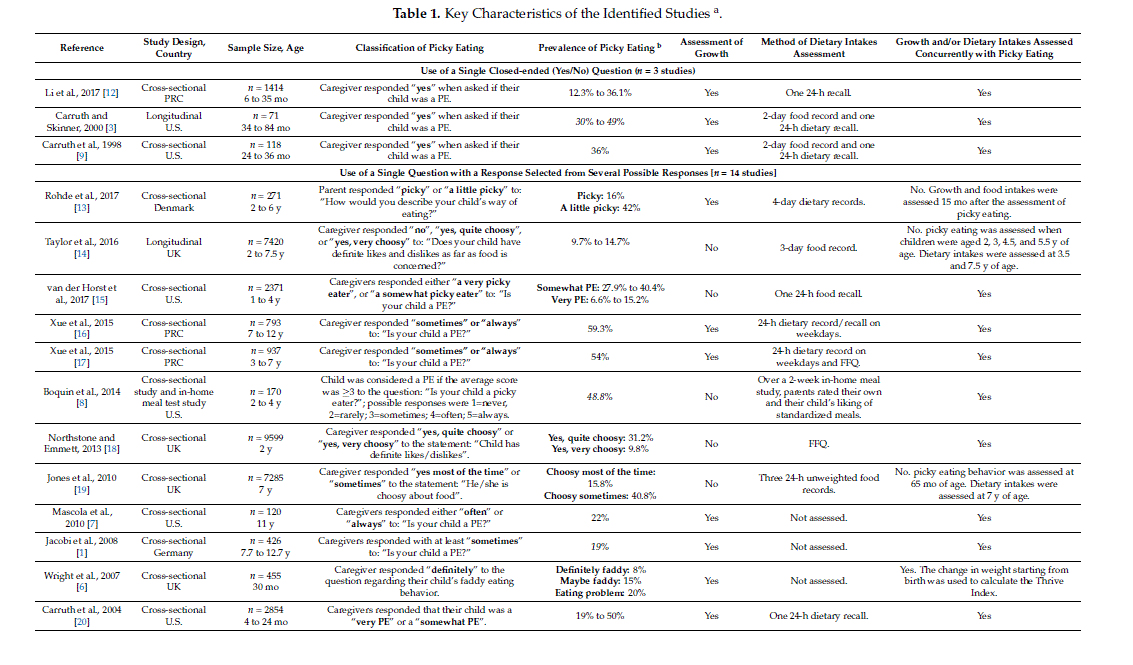
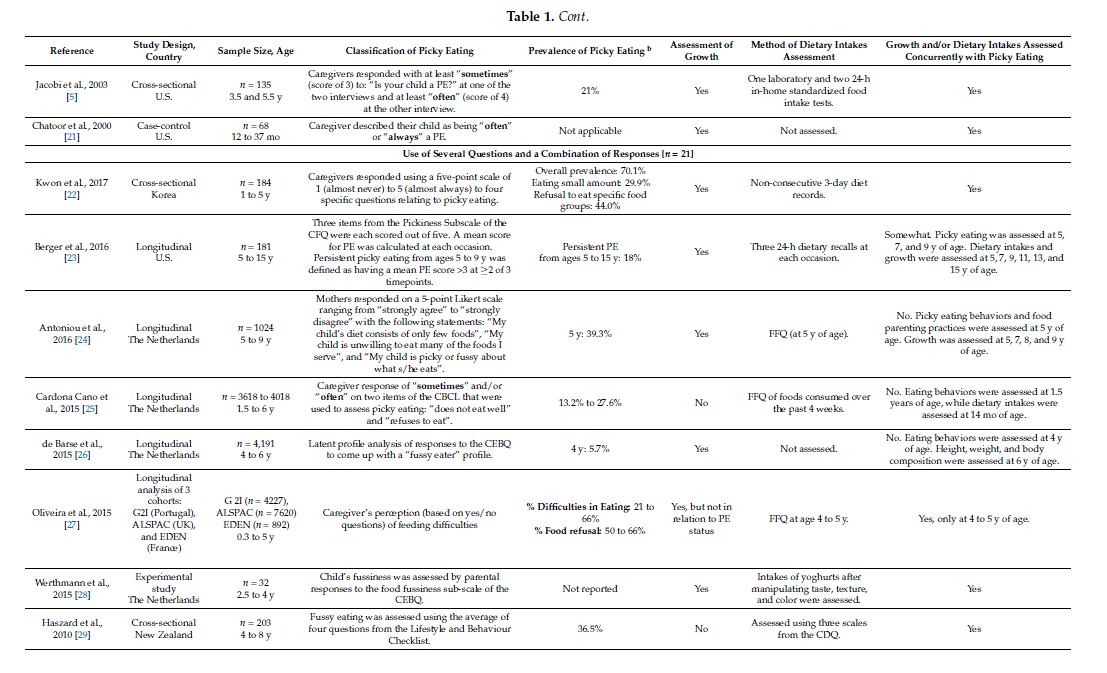
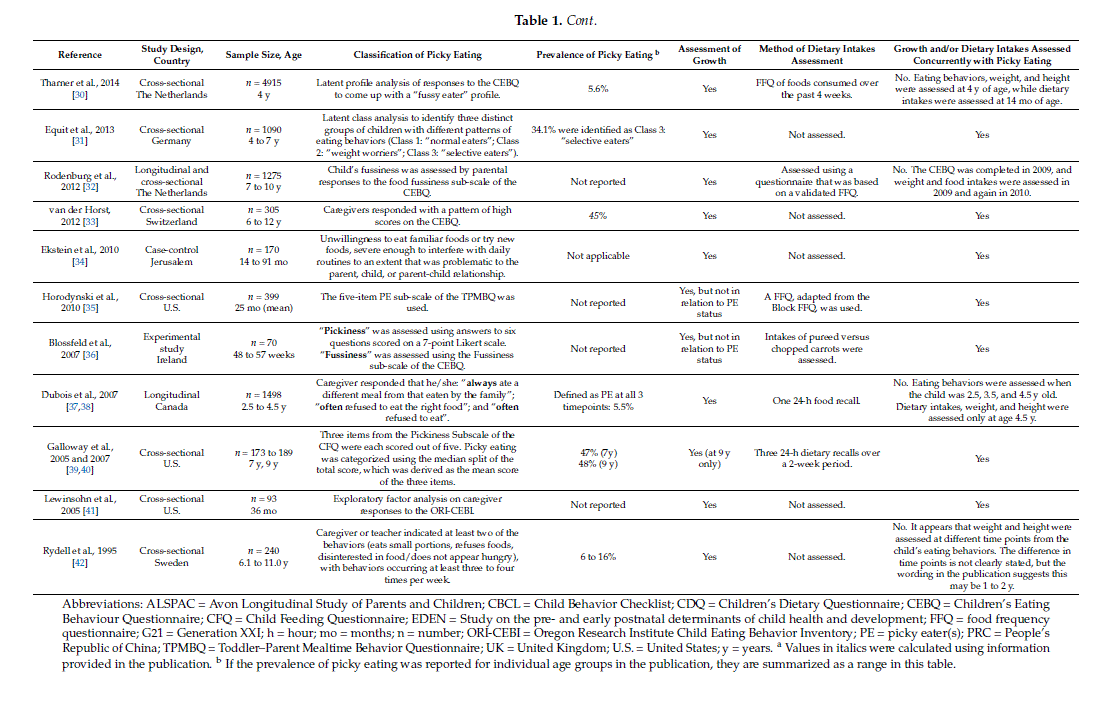
In the remaining 21 studies, responses to a series of questions were used to determine whether the child was a picky eater [22–42]. The tool used most frequently was the Child Eating Behaviour Questionnaire (CEBQ) [43,44], which is a validated 35-item questionnaire, with questions scored on a 5-point Likert scale [responses varied from “never” (score of 1) to “always” (score of 5)]. Six different eating profiles were identified (i.e., “fussy eater”, “moderate eater”, “avoidant eater”, “responsive eater”, “joyful eater”, “approaching eater”), and participants were assigned to one of these profiles based on the highest probability of profile membership. Children classified as having a “fussy eater” profile were characterized by a pattern of high scores in the food avoidance scales (i.e., food fussiness, satiety responsiveness, and slowness in eating) and low scores on the food approach scales (i.e., enjoyment of food and food responsiveness). Within studies, it was demonstrated that how picky eating was defined very much determined the prevalence of picky eating. For instance, in the study by Kwon et al. [22], the prevalence of picky eating was 29.9% when defined by eating a small amount of food and 44.0% when defined by a refusal to eat specific food groups. Likewise, Rydell et al. [42] reported differences in the prevalence of picky eating, depending on where the determination was made: 16% of the children were defined as picky eaters in school but not at home, 6% of the children were defined as picky eaters at home but not in school, while 8.5% of the children exhibited at least one picky eating behavior both at home and in school. Across the 21 studies, the average age of the children ranged from 4 months to 15 years, and the prevalence of picky eating ranged from 5.5 to 70.1%.
As can be seen in Table 1, dietary intakes were assessed in 28 of the studies; across 24 of these studies, the tools used to assess dietary intakes varied and generally included food frequency questionnaires (FFQs) or food records (varying in duration from 1 to 4 days). In the remaining four studies, dietary intakes were assessed experimentally; children were administered standardized test meals, and their acceptability and intakes were assessed by parents [5,8], or the intakes of yoghurts with differing tastes, textures, and colors [28], or pureed versus chopped carrots [36] were assessed. Growth or body weight in picky versus non-picky eaters was assessed in 27 of the studies.
Food/Food Group Intakes in Picky and Non-Picky Eaters
Several researchers have examined whether food intakes, particularly intakes of foods from the major food groups (i.e., cereals/grains, vegetables, fruits, dairy, and meats), differ in children perceived to be picky eaters compared to non-picky eaters, using data collected from dietary intake surveys (i.e., parentally-completed 24-h dietary recalls, food records, or FFQs). These studies are summarized in Table 2 (where the intakes of foods from the different food groups in picky and non-picky eaters are presented), Table 3 (where the intakes of discretionary foods and mixed dishes in picky and non-picky eaters are presented), and Table 4 (where the relationships between picky eater status and the intakes of foods from the different food groups are presented). In addition to the studies summarized in Table 2, Table 3, and Table 4, Boquin et al. [8] noted that non-picky eaters consumed a higher percentage of a standardized meal when compared to picky eaters, while Northstone and Emmett [18] reported that children who were described as “choosy” had lower dietary pattern scores, indicative of their lower variety of foods consumed. Of note, in some of the studies reviewed, the time point at which picky eating behavior was assessed differed from when the food intake data were collected [13,14,19,25,30]. In a few studies, food intakes and picky eating behaviors were both assessed concurrently, as well as at older ages [23,32,37,38].
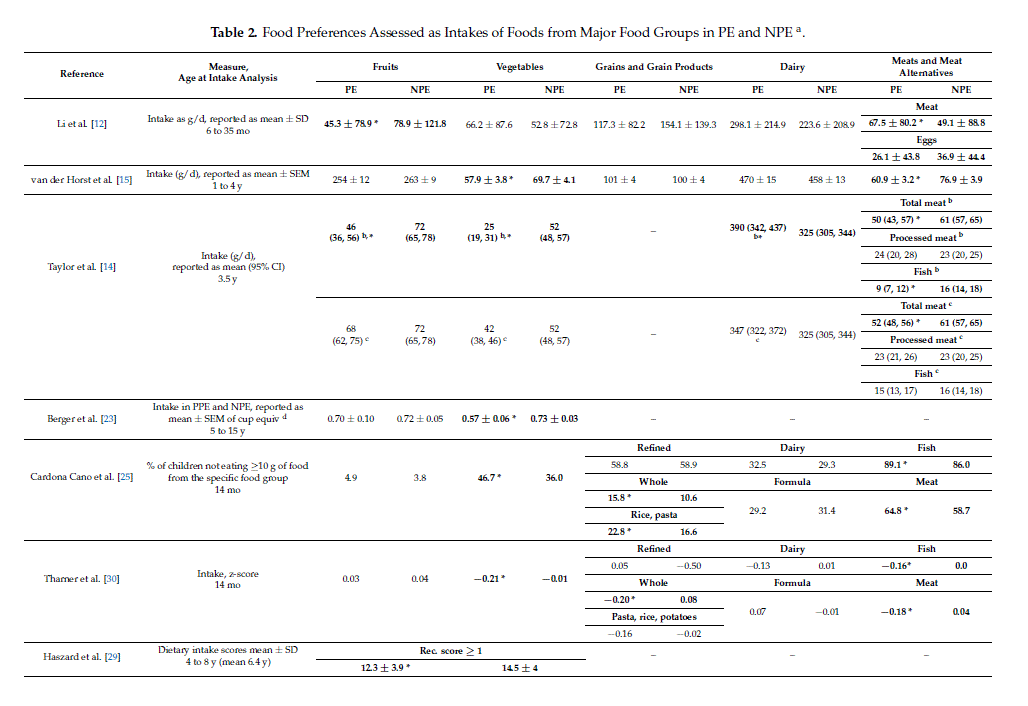

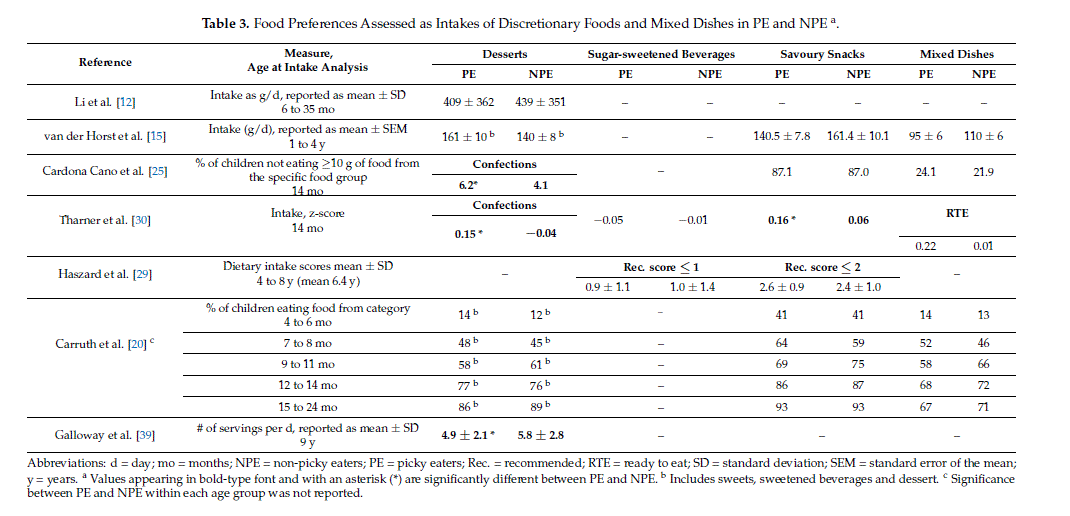
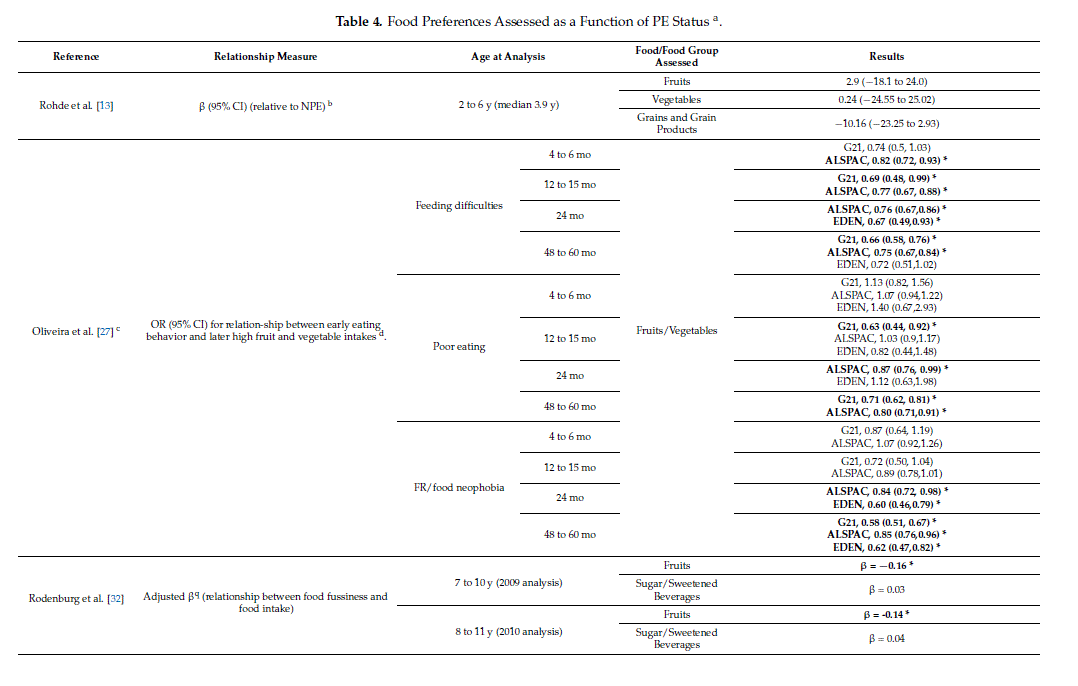
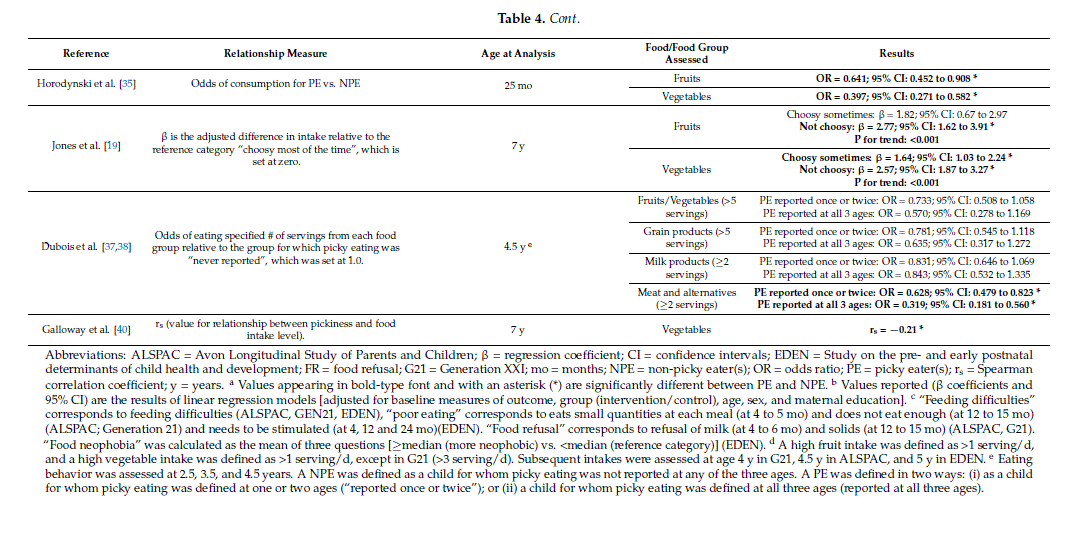
The intakes of foods from the various food groups were reported differently across the studies. In several of the studies, intakes in picky versus non-picky eaters were reported as amounts of foods consumed (in g/day) from specific food groups [12,14,15] or as the number of servings or cup equivalents of foods from specific food groups [23,39]. In other studies, the results were reported as the odds of consuming foods or a certain number of servings of foods from a specific food group in picky versus non-picky eaters [13,27,35,37,38]. While Carruth et al. [20] reported on the percentage of picky versus non-picky children who consumed foods from the various food groups, Cardona Cano et al. [25] reported on the percentage of picky versus non-picky eaters who did not consume at least 10 g/day of foods from the specific food group. In the remaining studies, differences between picky and non-picky eaters were reported as beta coefficients [13,19,32], dietary intake scores [29,30], or correlation coefficients [40].
Carruth et al. [20] reported that no major differences were evident in the proportion of picky versus non-picky eaters (age 4 to 24 months of age) who consumed foods from each of the major food groups. However, the data were not analyzed statistically, and the intakes of foods from the major food groups were assessed based on a single 24-h dietary recall, with any amount of food that was consumed qualifying the child as a consumer of that food group.
Fruits and vegetables
Significantly lower intakes of vegetables were reported in picky versus non-picky eaters in 10 of 13 studies [12,14,19,23,25,30,33,35,39,40]. The intakes of fruits were significantly lower in picky versus non-picky eaters in 7 of the 13 studies [12,14,19,29,32,35,39]. When fruit and vegetable intakes were assessed collectively as one group, intakes were significantly reduced in picky versus non-picky eaters in the majority of analyses conducted by Oliveira et al. [27], but not in the analysis conducted by Dubois et al. [37,38]; however, in this latter study, the odds of consuming five or more servings of fruits and vegetables in picky versus non-picky eaters was assessed.
Grain and grain products
There was generally no difference between picky and non-picky eaters in the intakes of grains and grain products [12,13,20,33,37–39]; however, when intakes of grains and grain products were separated further into refined, whole grain and starchy grains (e.g., rice, pasta, potatoes), differences between picky and non-picky eaters became more discernible. Specifically, in the study by Cardona Cano et al. [25], intakes of refined grains and grain products were similar between picky and non-picky eaters; but, intakes of whole grains and rice and pasta were significantly lower in picky versus non-picky eaters. Likewise, in the study by Tharner et al. [30], intakes of refined grains and pasta, rice and potatoes, when expressed as z-scores, were not different between picky and non-picky eaters; however, intakes of whole grains, when expressed as z-scores, were significantly lower in picky versus non-picky eaters.
Dairy intakes
Dairy intakes—including formula intakes—were largely similar between picky and non-picky eaters [12,20,25,30,33,37–39], except in the study by Taylor et al. [14], wherein picky eaters (but not somewhat picky eaters) were noted to have significantly greater intakes of dairy compared to non-picky eaters.
Meats and meat alternatives
In the majority of studies, meat intakes were significantly lower in picky versus non-picky eaters [14,25,30,33,37,38]. In two studies, meat intakes between picky and non-picky eaters were not significantly different [20,39], and in one study meat intakes were significantly greater in picky versus non-picky eaters [12]. Intakes of eggs, which were assessed individually only in one study, were significantly lower in picky versus non-picky eaters [12]. Fish intakes were significantly lower in picky versus non-picky eaters in all three studies in which this was assessed [14,25,30]. Intakes of processed meats in picky versus non-picky eaters, which were assessed in a single study, were similar [14].
Intakes of specific foods or food categories: In some of the identified studies, the intakes of generally well-liked but unhealthy foods (e.g., desserts, confectionaries, savory snacks, and sugar-sweetened beverages) in picky versus non-picky eaters were assessed. The outcomes of these studies are largely inconsistent. For example, children identified as picky eaters at 1.5 years of age were more likely to refuse confectionaries at the age of 14 months compared to non-picky eaters [25], yet the children who were later identified as fussy eaters at the age of 4 years consumed significantly more quantities of savory snacks and confectionaries when they were younger (at age 14 months) compared to non-fussy eaters [30]. In studies in which eating behaviors and dietary intakes were assessed at the same time point, picky eating was associated with significantly lower intakes of “fats and sweets” in 9-year-old girls [39], but not in two other studies in children 1 to 4 years of age [33] and 2 to 6 years of age [12], in which intakes of sweets and desserts were similar in picky and non-picky eaters. No differences were reported between picky and non-picky eaters in intakes of sugar-sweetened beverages [29,30,32] and savory snacks [33], except in one study in which a significantly higher intake of savory snacks was reported in picky versus non-picky eaters [30]. Overall, there was a limited number of studies in which the intakes of specific foods or categories of foods in picky and non-picky eaters were compared.
Energy, Macronutrient and Fiber Intakes in Picky and Non-Picky Eaters
Several investigators have compared the energy, macronutrient, and fiber intakes of picky eaters and non-picky eaters. The results of these studies are presented in Table 5. It should be noted that in the study by Carruth and Skinner [3], intakes of energy and protein were assessed in picky eaters, but not in non-picky eaters. Thus, intakes of energy and protein in picky eaters were compared to age-specific dietary recommendations by the study authors.
Energy intakes were noted to be significantly lower in picky versus non-picky eaters in six studies [5,16,17,20,22,25,37,38]; but, in nine other studies, energy intakes in picky and non-picky eaters were similar [3,9,12–14,17,24,30,39]. The ability to discern a difference in energy intakes between picky and non-picky eaters may be a function of how picky eating is defined. For instance, in the study by Kwon et al. [22], energy intakes were significantly lower in picky eaters versus non-picky eaters when picky eating was defined as “eating small amounts”, but not as “the refusal of ≥2 food groups”. In several of the other studies in which energy intakes were found to be significantly lower in picky versus non-picky eaters, picky eating was defined using more than one qualifying criterion. For example, in the study by Cardona Cano et al. [25], picky eating was defined as “sometimes” or “often” does not eat well and refuses to eat. In the study by Dubois et al. [37,38], picky eating was defined as “always” ate a different meal from that eaten by the family, “often” refused to eat the right food, and “often” refused to eat. In the study by Jacobi et al. [5], caregivers had to answer at least “sometimes” at one interview and “often” at the other interview to the question, “Is your child a picky eater?”.
Intakes of the macronutrients were generally reported in grams/day or as a percentage of total daily energy intake. Protein intake was reported to be significantly lower in picky versus non-picky eaters in five studies [14,16,17,37,38] [only in “very choosy” but not “quite choosy” children]; [13] but not in five other studies [9,12,20,22,39]. Carbohydrate intakes were reported to be significantly lower in picky versus non-picky eaters in two studies [20], in infants aged 7 to 8 months; [16,17]; however, in one study [37,38], the percentage contribution of carbohydrate to total daily energy intake was significantly greater in picky versus non-picky eaters. In the majority of studies, picky and non-picky eaters were found to have similar intakes of carbohydrate [9,12–14,17,20,22,39]. Intakes of fat were generally similar in picky and non-picky eaters, with significant differences reported only in three studies. Specifically, fat intakes were reported to be significantly lower in picky versus non-picky eaters in two studies [20], in infants 9 to 11 months but not in infants 7 to 8 months; [37,38] and significantly greater in picky versus non-picky eaters in a single age group in one study [12]. Fiber intakes in picky and non-picky eaters were assessed only in four studies, and although intakes were consistently lower in picky versus non-picky eaters in all four studies, the differences between groups were significant only in two studies [16,39].
The effects of early eating behavior on later intakes of macronutrients were assessed in a limited number of longitudinal studies. Dubois et al. [37,38] reported that children who were considered to be picky eaters at age 2.5, 3.5, or 4.5 years consumed significantly less fat (by 3 g), significantly less protein (by approximately 6 g) and significantly more carbohydrate (by about 1.2 g) at age 4.5 years, in comparison to children who were never reported to be picky eaters. Taylor et al. [14] reported that children with persistent picky eating during the ages of 2.0 to 5.0 years relative to those with no persistent picky eating behaviors had slightly but significantly lower intakes of protein (by approximately 2 g), and slightly but significantly greater free sugar intakes (by approximately 1 g), but similar fat and total carbohydrate intakes at 7.5 years of age.
Micronutrient Intakes in Picky and Non-Picky Eaters
With regard to the intakes of vitamins and minerals (see Tables 6–8), Carruth et al. [20] have reported that intakes of certain vitamins and minerals, among infants 7 to 11 months old may be significantly lower among picky eaters in comparison to non-picky eaters. Even so, the study authors noted that the mean levels of intake for all nutrients were well above the recommended dietary allowances (RDA) or adequate intakes (AI) for both picky and non-picky eaters [20]. In a study of 9-year-old girls, picky eaters had significantly lower intakes of vitamin E, vitamin C, and folate [39], and the reduced intakes are likely reflective of their selective food preferences and lower intakes of specific food groups such as fruits and vegetables. Interestingly, the proportion of girls considered to be “at risk” for nutrient inadequacy (i.e., not meeting the Estimated Average Requirements [EAR]) was significantly higher in picky compared to non-picky eaters for vitamin E (98% versus 88%, respectively) and for vitamin C (28% versus 12%, respectively), but not for folate (30% versus 23%, respectively) [39]. Recent studies consistently show lower intakes of iron, zinc, and vitamins A, C, E, B1, B2, and B3 among picky eaters compared to non-picky eaters [12,14,16,17,22], although intakes of most of these nutrients do not appear way below the recommendations. Of note, some nutrients such as iron, zinc, and vitamin D are low among both picky and non-picky eaters. To exemplify this, in the Avon Longitudinal study, one-half to three-fourths of all the children (including both picky and non-picky eaters) had intakes below the recommended levels for iron and zinc, although a significantly higher number of picky eaters had intakes of iron below the recommended intakes when compared to non-picky eaters [14].
Growth/Body Weight Status in Picky and Non-Picky Eaters
The relationship between picky eating and growth has been examined in numerous studies, as summarized in Table 9. It has been reported in some studies that compared to non-picky eaters, picky eaters have statistically significantly lower body mass indices (BMIs) [16,17,22,24,26,30,32,39], lower percentages of body fat [39], and lower fat mass and fat-free mass indices [26]. In some of these studies, when compared to non-picky eaters, picky eaters were also more likely to be classified as being underweight [30], and were less likely to be overweight or obese [24,39]. Picky eaters were reported to have a greater odds of being underweight [34,37]; moreover, having a higher weight-for-age has been associated with significantly lower odds of being a picky eater [20]. In one study, the change in the BMI standard deviation scores between picky eaters and non-picky eaters, which was evaluated from 4 to 6 years, was significantly smaller in picky eaters, mainly driven by a decrease in fat-free mass [26]. Picky eaters have also been reported to be shorter in height compared to non-picky eaters [16,24]. As with the assessment of food intakes, in some of the studies reviewed, the time point at which picky eating behavior was evaluated was not necessarily the same as when growth parameters were measured [13,23,24,26,32,37,38,42].
In contrast, other investigators have not observed any significant associations between anthropometric measures and picky eating behaviors. It was reported in a number of studies that there is no statistically significant difference in mean body weight or height [3,9,34], BMI [1,5,7,28,41], BMI z-scores [13], proportion of children underweight [12,23], overweight [12] or in changes in BMI over a longitudinal follow up of 15 months [13] between picky and non-picky eaters. Rydell et al. [42] reported that “choosy children” were not significantly more likely to have weight:height scores of-1 standard deviation, and van der Horst [33] found that picky eaters were not more likely to be underweight compared to children with less picky eating behaviors. Similarly, Equit et al. [31] reported that “selective eaters” were not significantly more likely to be underweight.
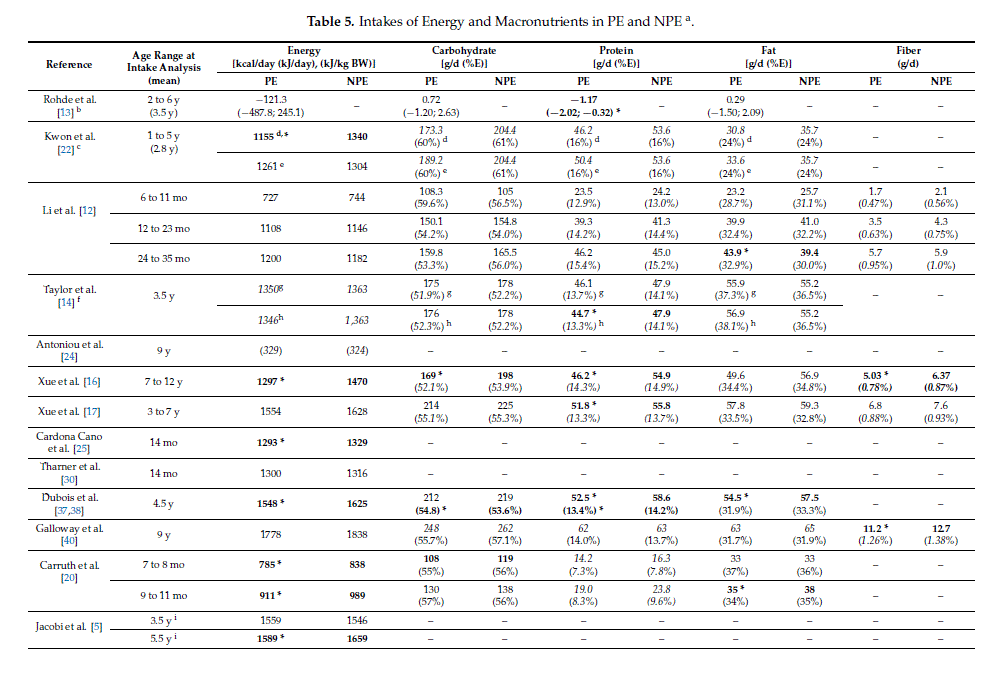
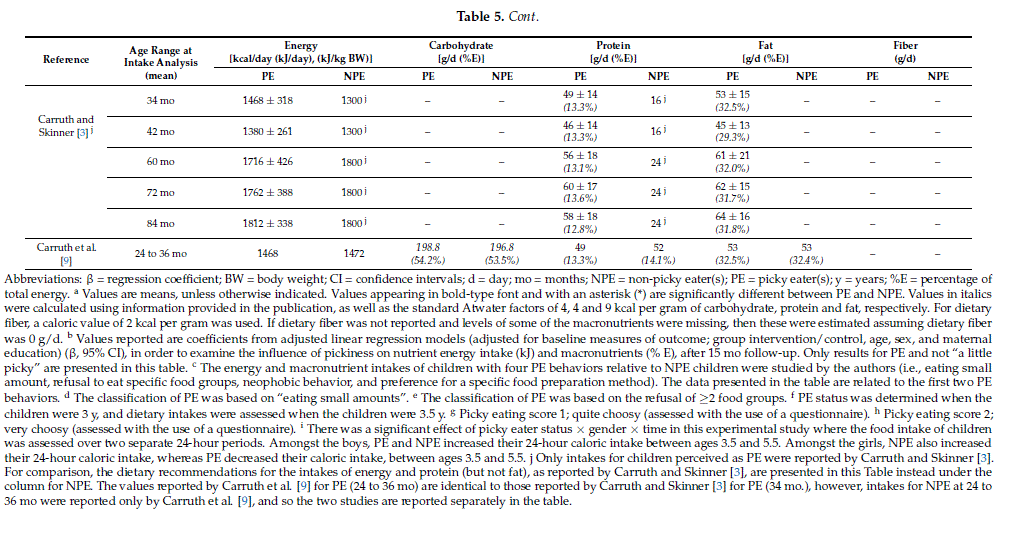
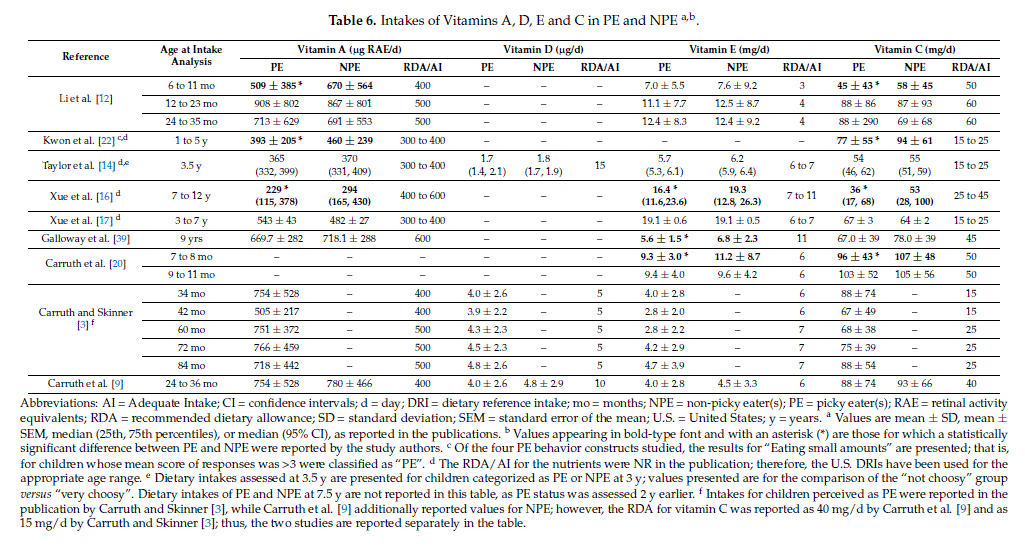
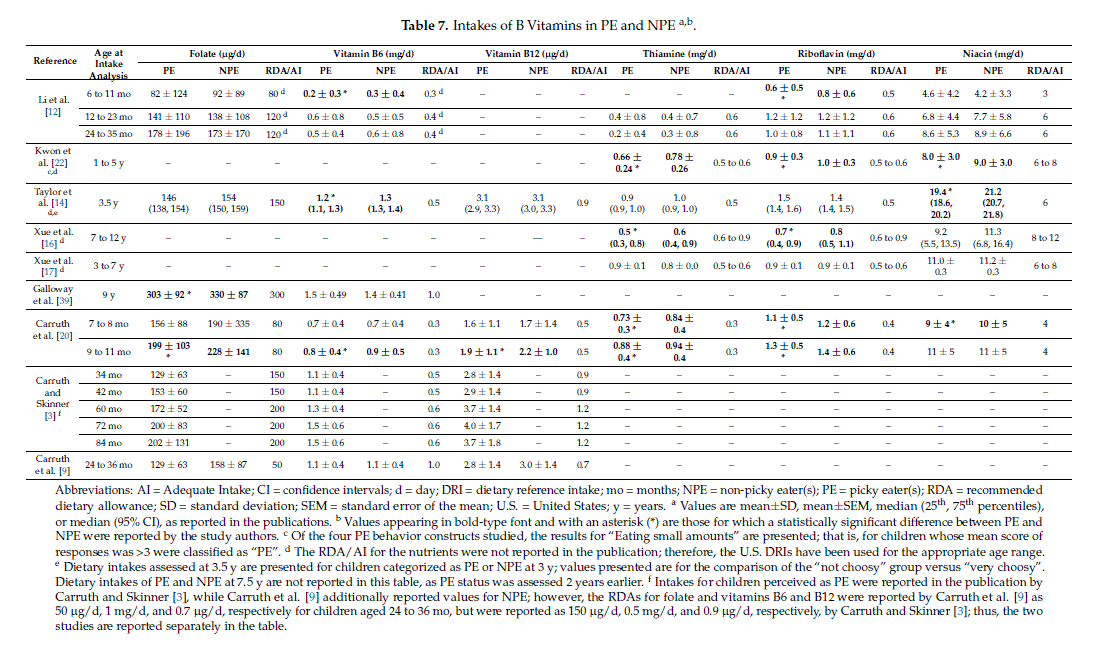
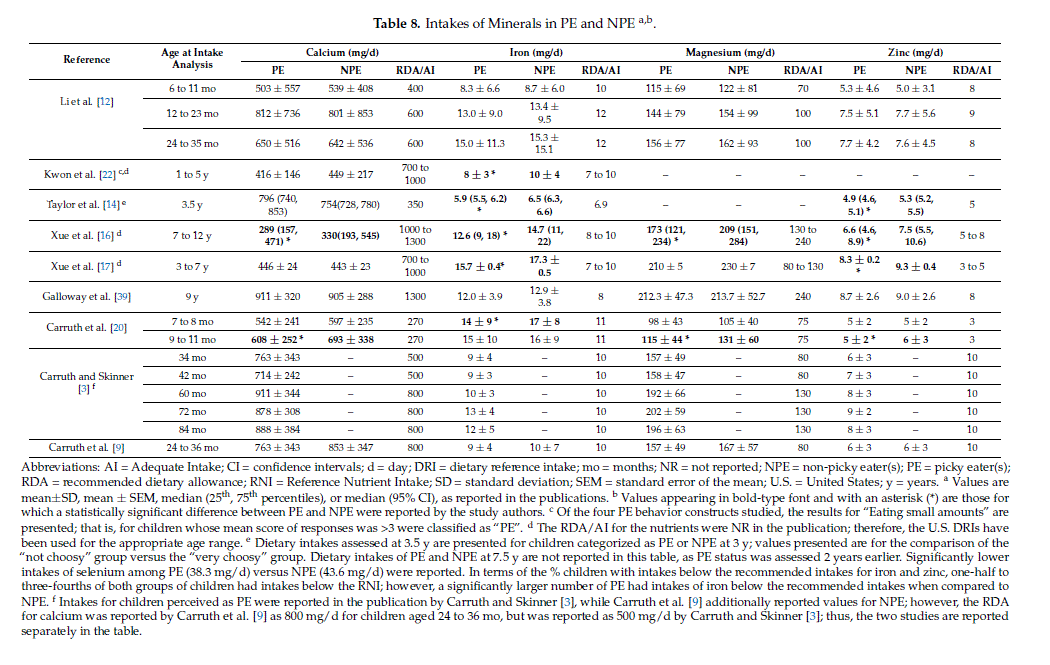
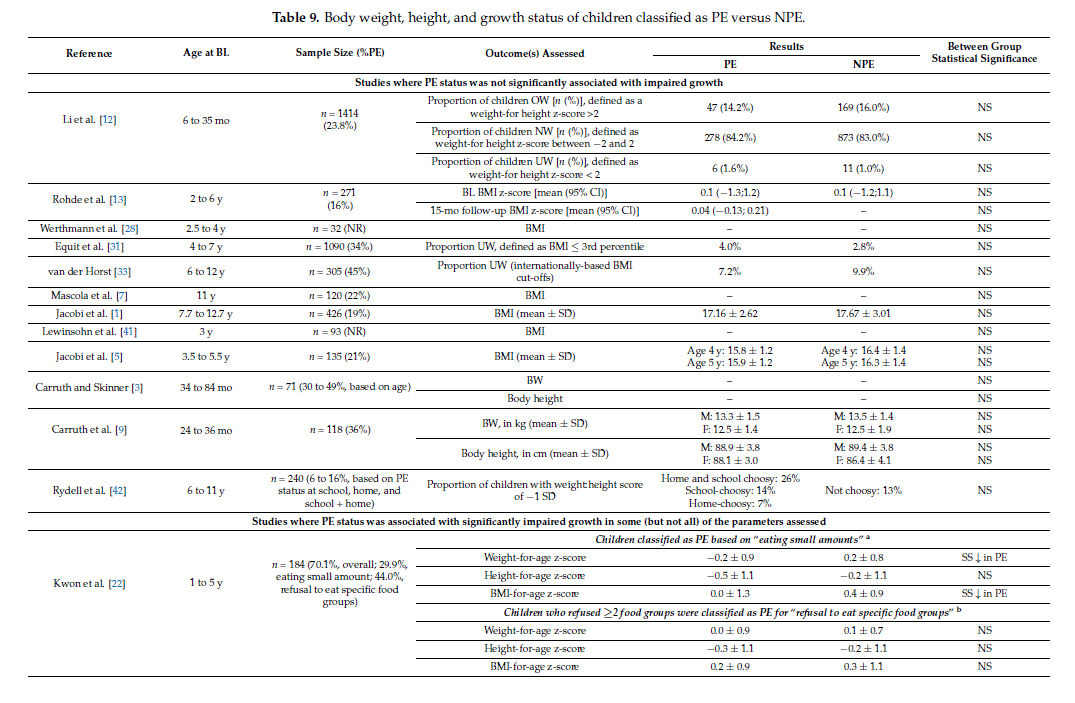
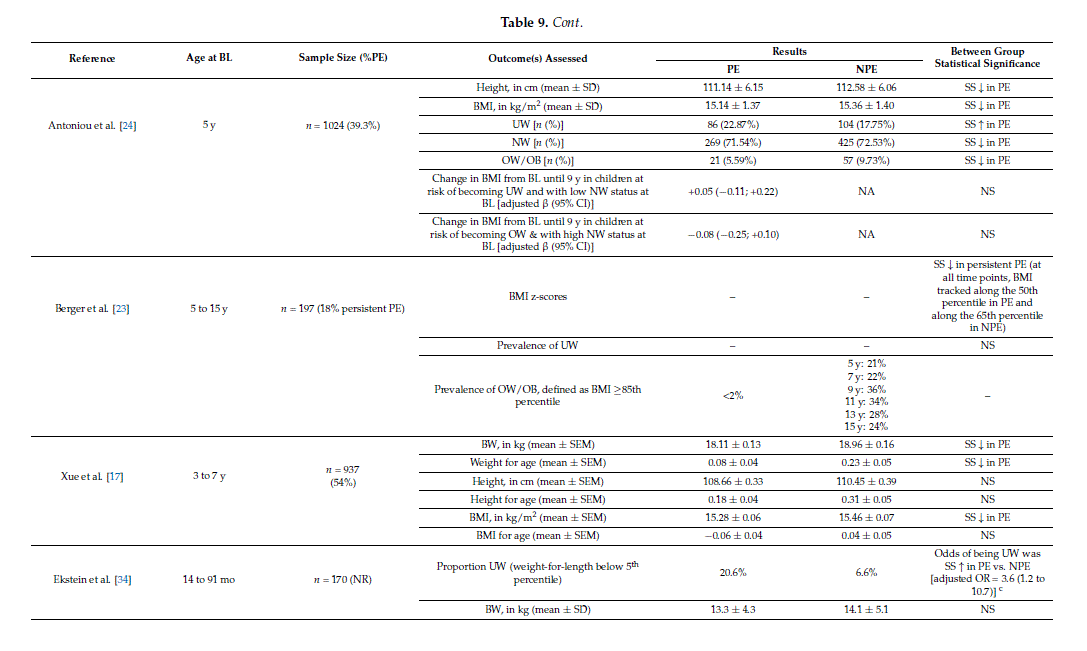
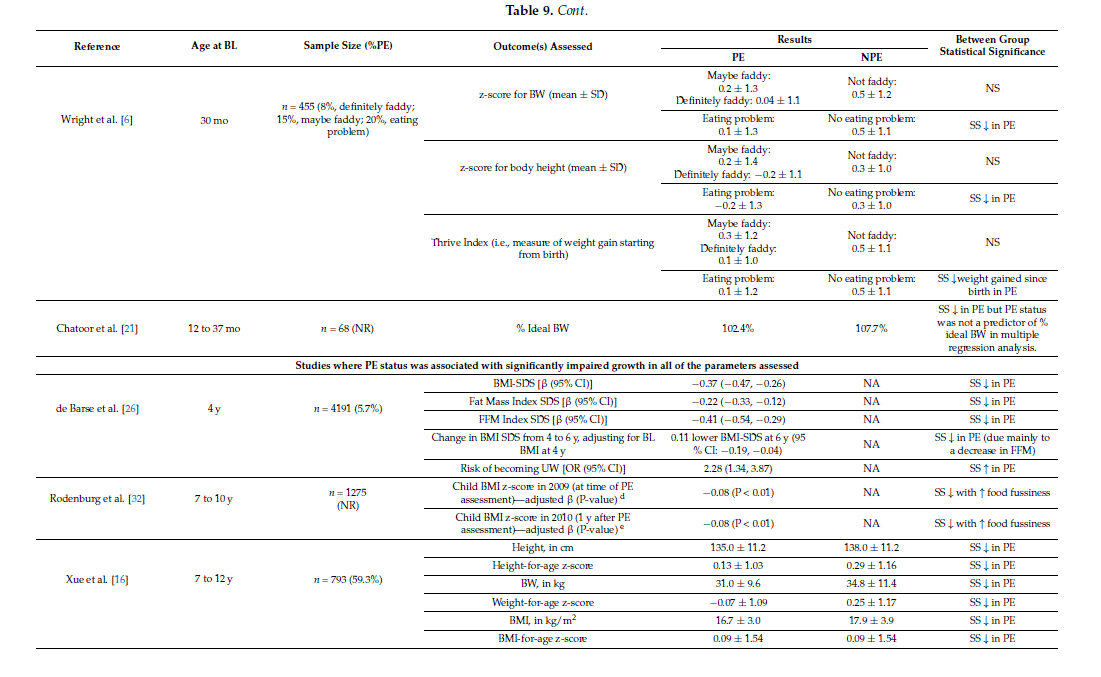
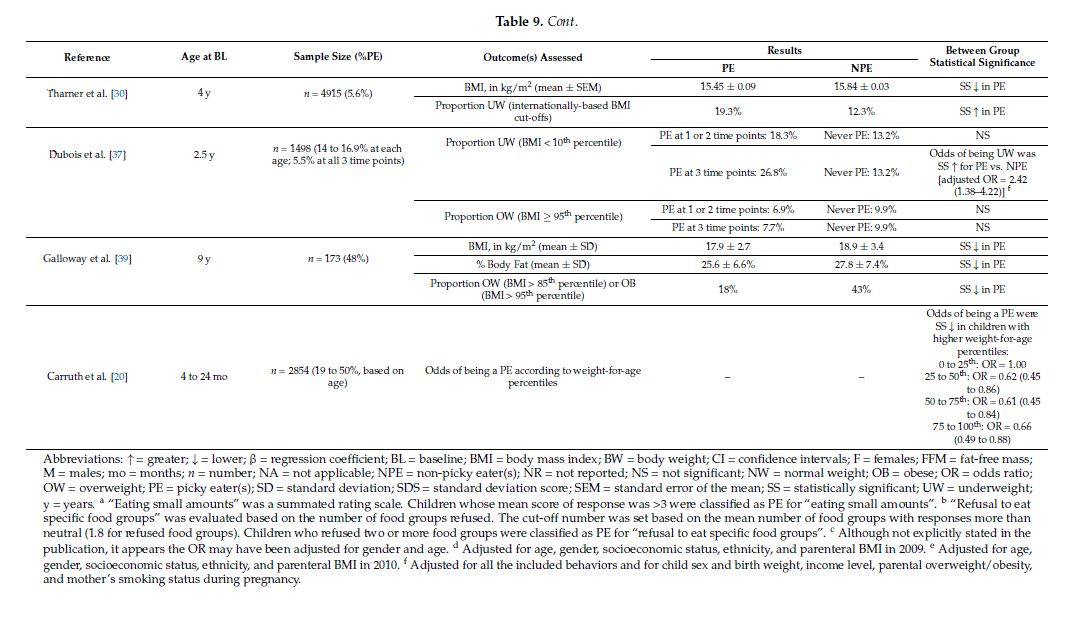
Still, other studies have reported only weak associations between picky eating and growth; for example, Wright et al. [6] reported that children considered to be “faddy” had a slight, non-statistically significant lower body weight, height and Thrive Index (a measure of weight gain starting from birth) compared to children who were not “faddy”. Interestingly, in this same study, children who were perceived to have an “eating problem” did have a statistically significant lower body weight and height and had gained less weight since birth. Chatoor et al. [21] reported that picky eaters had a significantly lower percent ideal body weight compared to non-picky eaters (102.4% versus 107.7%, respectively), but that picky eating status was not a significant predictor of the percent ideal body weight [21].
Discussion
One of the defining features of picky eating is that the types of foods consumed tend to be limited (i.e., selective eating), with the child exhibiting strong food preferences and food dislikes [1,3,4,6,9]. Parents of picky eaters are also more likely to report that their child does not consume an adequate amount of food at each meal [4,8], or that the child does not eat the amount of food that the parents think they should be eating [3,9].
There is some evidence from the literature to suggest that picky eaters do have less intakes of certain foods/food groups compared to non-picky eaters, when intake was assessed using data collected from dietary intake surveys (24-h dietary recalls, food records, or FFQ). Notably, when compared to non-picky eaters, picky eaters have been reported to consume less fruits and vegetables[12,14,15,19,23,25,27,29,30,32,33,35,39,40], whole grains [25,30], and meat and fish [14,25,30,33,37,38], with the most consistent finding related to the reduced consumption of vegetables in picky versus non-picky eaters. Caution is warranted in interpreting these findings since the extent to which the parents were regulating the child’s food intake is not known. For example, it is unclear whether the lower intake of certain food groups is attributable to the child’s refusal to eat such foods, or whether the foods were simply not offered to the child by the parents, either because the parents know that the child will not eat the food, or for other reasons such as affordability. To avoid these potential confounders, several investigators have evaluated whether food intake differs between picky eaters and non-picky eaters under an experimental setting. Similar to the data collected from dietary intake surveys, the results from two such experimental studies identified in this review suggest that the food choices of picky eaters do differ in some respects when compared to those of non-picky eaters [5,8]. For instance, picky eaters were more likely to avoid vegetables in both of these studies. Thus, vegetable intakes, which tend to be low in general, are even lower in picky eaters.
Varying results have also been reported in studies that included an assessment of energy, macronutrient, and dietary fiber intakes. Although picky eaters had significantly lower intakes of protein than non-picky eaters in some of the identified studies [13,14,16,17,37,38], overall, the intakes of protein were sufficient, both in picky-eaters and non-picky eaters in all age groups assessed. In fact, dietary protein intakes were generally in excess of the European Food Safety Authority (EFSA) dietary recommendations for protein for all age groups. For example, using EFSA’s dietary protein recommendations (specifically, the Population Reference Intakes, which are age- and gender-specific and intended to meet the needs of 97.5% of the population) [45] and reference body weights for European children [46], dietary protein recommendations are 11 to 13 g/day for children 1 to 3 years of age. As per Table 5, dietary protein intakes among children 1 to 3 years of age—irrespective of picky eating behavior—were 39.3 to 50 g/day, representing intakes that were 3.5- to 4.5-fold greater than EFSA’s dietary protein recommendations. On the other hand, fat intakes were generally low in children 1 to 3 years of age (24 to 32% E versus 35 to 40% E of EFSA’s reference intake range [47] for this age group) in both picky eaters and non-picky eaters [3,9,12]; but, in most studies of children 3 years of age and older [16,17,38,39], fat intakes were within EFSA’s reference intake range of 20–35% E for this age group [47]. Dietary fiber intakes need to be increased in children in general, regardless of whether they are a picky eaters or not, although there is evidence to suggest the intake of dietary fiber may be even lower amongst picky eaters [16,39]. The data on consequences of early picky eating behavior [14] and persistent picky eating [38] on later macronutrient intakes are too limited to draw any conclusions. With regard to micronutrients, based on the studies reviewed herein (in at least one of the subgroups examined), picky eaters had significantly lower intakes of certain micronutrients such as iron [14,16,17,20,22], zinc [14,16,17,20], vitamins A [12,16], B6 [12,14,20], C [12,16,20,22], E [16,20,39], thiamine [16,20,22], riboflavin [12,16,20,22], and niacin [14,20,22] compared to non-picky eaters. While intakes in most of these studies were close to recommended values, Taylor et al. [14] noted that the intakes of iron and zinc were below the recommendations in both groups, making it equally important to address these gaps in the general population. Another way to assess nutritional status is to directly measure the levels of micronutrients in blood samples; however, due to the invasive nature of blood sampling, it is not often employed in large-scale studies of young children. Two recent studies have measured the nutrient status of pre-school- and school-aged children and reported significantly lower levels of iron, magnesium, and copper in the blood of school-aged picky eaters compared to non-picky eaters [16], although no such differences were observed in preschool children [17]. If the school-aged picky eaters were picky eaters earlier in life, then there is some suggestion that the persistence of picky eating may have adverse consequences on nutritional status in the long-term.
Rather than examining food/nutrient intakes individually, perhaps a better approach would be to use dietary indices and/or dietary patterns reflecting the overall quality of the diet or adherence to a dietary recommendation, the results of which may be easily understood by the general population. As an example, the Youth Healthy Eating Index (HEI) [48] was constructed for use specifically in children and adolescents. Other examples are the Finnish Children Healthy Eating Index (FCHEI) [49] and the Chinese Children Dietary Index [50]; both scoring systems were developed to assess overall diet quality among children in their respective countries.
There does not appear to be a clear association between picky eating and childhood growth/body weight status across the studies identified in this current review. Similarly, in a recent systematic review, Brown and colleagues [51] reported inconsistent findings among the studies evaluating whether associations exist between picky eating or food neophobia and weight status; in comparison with picky eating or food neophobia, 17 studies found no association with weight status, 2 studies found a positive association with overweight status, 5 studies found a negative association with overweight or obesity status, 6 studies found a positive association with underweight status, and 11 studies found a decreased association with BMI or BMI z-score. It should be noted, however, that studies that used a larger number of qualifying criteria in their classification of picky eating generally reported a significant difference in the growth/weight status of picky versus non-picky eaters. Among the seven studies [16, 20,26,30,32,37,38] in which all parameters related to growth/weight were significantly poorer in picky versus non-picky eaters, only in two studies [16,20] was the picky eating classification based on a single question; in the remaining five studies [26,30,32,37,38], the classification of the children as picky eaters was based on multiple defining criteria. Likewise, among the seven studies [6,17,21–24,34] in which some but not all parameters related to growth/body weight were significantly inferior in picky versus non-picky eaters, only in three studies [6,17,21] was the picky eating classification based on a single question, while in the remaining four studies [22–24,34], the classification of the children as picky eaters was based on multiple defining criteria. In the 12 studies [1,3,5,7,9,12,13,28,31,33,41,42] in which there was no difference between picky and non-picky eaters in growth/body weight, in the majority of studies (i.e., seven), the classification of picky eating was based only on a single question. Perhaps a single question is not sufficient to differentiate picky from non-picky eaters, and the greater the number of defining criteria, the more accurately true picky eating can be identified. In addition to how picky eating was defined, there are other factors that could have contributed to the lack of a consistent finding across the studies (e.g., whether the growth parameters were parentally reported or were assessed directly by investigators and the actual growth parameter assessed). Moreover, the studies reviewed herein consisted mainly of healthy children without any formal diagnosis of eating disorders.
The lack of consistent findings between picky eating and food/nutrient intake or growth/body weight status across the different studies in the literature highlights the various challenges faced by researchers in this field. For one, there is no concise definition for picky eating that has been widely adopted in the literature. There are several different ways by which researchers have identified picky eaters or defined picky eating in studies, ranging from the simple question, “Is your child a picky eater?”, which is highly subjective and requires interpretation by the responder, to the use of more complex tools that rely on a combination of responses related to picky eating behaviors. A single question may not be sufficient to delineate between parental perception of picky eating and true picky eating, and so a tool that incorporates several different eating behaviors that are problematic in picky eaters, such as the CEBQ, may be more sensitive in identifying true picky eating. Understandably, there are many difficulties in deriving a widely accepted definition of what constitutes picky eating. As with any other human behavior, picky eating is highly complex; it is constantly evolving even within an individual and is likely to change with age. However, many of the studies identified herein were cross-sectional in design. Therefore, more longitudinal studies are needed to better characterize picky eating over time, to better understand whether such behaviors are transient phenomena or persist over time, and to identify the most relevant and sensitive age range wherein picky eating has the greatest impact on food choices or health outcomes later in life. Finally, some consensus on the most sensitive or pertinent dietary intake and growth measures is needed, as the results for these outcomes were reported with heterogeneity across the studies. The tools used to assess dietary intakes varied across the studies, with some using a single 24-h dietary recall, others using multiple 24-h recalls, and others a FFQ. The way the results were expressed was also highly variable. For instance, across studies, the intake of fruits and vegetables in picky and non-picky eaters was expressed as amount (g) per day, the proportion of children consuming a minimum amount, or as an odds ratio. Likewise, for body weight, there was little consistency in how the outcomes were reported across studies (e.g., z-score, BMI, OR of being underweight, normal weight, or over weight, etc.).
There is a wealth of literature published on picky eating during childhood, and across a broad range of ages, as evidenced from this review. There appears to be the general consensus that picky eating (or “selective food choice”), to some extent, is a normal part of the child development process and does not negatively impact growth or nutritional status. However, on an individual basis, it is important to differentiate picky eating behaviors from the more serious eating disorders that could have negative implications on health (e.g., growth impediment, nutritional deficiency, or other functional impairments). Efforts should be made to ensure that all children, especially those with perceived picky eating, consume a nutritionally balanced and varied diet in accordance with the recommendations set forth in the current dietary guidelines. It is important to continue to promote healthy eating habits among children in general, particularly in children with perceived picky eating, by providing repeated exposure to a variety of foods, offering age-appropriate textures/portion sizes, using appropriate feeding techniques, practicing responsive feeding, and role modelling of food choices.
The limitations of this narrative review should be mentioned. First, the evidence is predominantly from cross-sectional studies, and it is well-known that dietary recall can be biased in such studies (e.g., parents of children who perceive their children as picky eaters may indicate poorer dietary intakes/habits than what the child actually exhibits). A limited number of longitudinal studies were identified, and such studies are important in understanding whether picky eating is a transient phenomenon with no long-term effects on growth or nutritional status or if picky eating is sustained, with more detrimental effects on nutritional status and growth in the long-term. Another limitation of this review is that the assessment presented herein is strictly qualitative—we did not pool results across studies (for example, the intakes of fruits and vegetables in picky versus non-picky eaters), and it is possible that a quantitative assessment (such as that afforded by a meta-analysis) may have increased our sensitivity in identifying differences between picky and non-picky eaters; however, the studies identified are too heterogeneous to pool (i.e., the studies differed considerably in how picky eating was defined, how dietary intakes were assessed, and how growth was monitored). Finally, given that the interest was in several different aspects of picky eating, such as diagnostic criteria, dietary intakes, body weight/growth status, and overall nutritional adequacy in picky versus non-picky eaters, the research was conducted and reported as a narrative review as opposed to a systematic review, and so it is likely that not all relevant studies have been captured. Nonetheless, the sampling of studies presented herein is robust, and the heterogeneity in critical research elements is evident. Research in the area of picky eating would benefit from increased alignment in how clinical studies are designed, how picky eating is identified, and the best methods for assessing and reporting nutritional intakes and growth.
References
- Jacobi, C.; Schmitz, G.; Agras, W.S. Is picky eating an eating disorder? Int. J. Eat. Disord. 2008, 41, 626–634. [CrossRef] [PubMed]
- Morton, H.; Santich, B.; Worsley, A. Mothers’ perspectives on the eating habits of two-year-olds: A pilot study.Aust. J. Nutr. Diet. 1996, 53, 100–105.
Carruth, B.R.; Skinner, J.D. Revisiting the picky eater phenomenon: Neophobic behaviors of young children.
- Boquin, M.M.; Moskowitz, H.R.; Donovan, S.M.; Lee, S.-Y. Defining perceptions of picky eating obtained through focus groups and conjoint analysis. J. Sens. Stud. 2014, 29, 126–138. [CrossRef]
- Jacobi, C.; Agras, W.S.; Bryson, S.; Hammer, L.D. Behavioural validation, precursors, and concomitants of picky eating in childhood. J. Am. Acad. Child Adolesc. Psychiatry 2003, 42, 76–84. [CrossRef]
- Wright, C.M.; Parkinson, K.N.; Shipton, D.; Drewett, R.F. How do toddler eating problems relate to their eating behaviour, food preferences, and growth? Pediatrics 2007, 120, e1069–e1075. [CrossRef]
Mascola, A.J.; Bryson, S.W.; Agras, W.S. Picky eating during childhood: A longitudinal study to age 11 years.
Eat. Behav. 2010, 11, 253–257. [CrossRef]
- Boquin, M.; Smith-Simpson, S.; Donovan, S.M.; Lee, S.Y. Mealtime behaviours and food consumption of perceived picky and nonpicky eaters through home use test. J. Food Sci. 2014, 79, S2523–S2532. [CrossRef]
- Carruth, B.R.; Skinner, J.; Houck, K.;Moran, J., III; Coletta, F.;Ott, D. The phenomenon of “picky eater”: A behavioral marker in eating patterns of toddlers. J. Am. Coll. Nutr. 1998, 17, 180–186. [CrossRef]
U.S. DHHS; USDA. 2015–2020 Dietary Guidelines for Americans, 8th edition; Departments of Health and Human Services (DHHS) and Agriculture (USDA): Washington, DC, USA, 2015.Available online:https:
//health.gov/dietaryguidelines/2015/guidelines/ (accessed on 17 August 2018).
- National Health and Medical Research Council.Eat for Health. Australian Dietary Guidelines:Providingthe Scientific Evidence for Healthier Australian Diets; Australian Government, National Health and Medical Research Council (NHMRC) & Department of Health and Aging: Canberra, Australia, 2013. Available online: http://www.nhmrc.gov.au/guidelines/publications/n55 (accessed on 17 August 2018).
- Li, Z.; van der Horst, K.; Edelson-Fries, L.R.; Yu, K.; You, L.; Zhang, Y.; Vinyes-Pares, G.; Wang, P.; Ma, D.; Yang, X.; et al. Perceptions of food intake and weight status among parents of picky eating infants and toddlers in China: A cross-sectional study. Appetite 2017, 108, 456–463. [CrossRef]
- Rohde, J.F.; Händel, M.N.; Stougaard, M.; Olsen, N.J.; Trærup, M.; Mortensen, E.L.; Heitmann, B.L. Relationship between pickiness and subsequent development in body mass index and diet intake in obesity prone normal weight preschool children. PLoS ONE 2017, 12, e0172772. [CrossRef] [PubMed]
- Taylor, C.M.; Northstone, K.; Wernimont, S.M.; Emmett, P.M. Macro- and micronutrient intakes in picky eaters: A cause for concern? Am. J. Clin. Nutr. 2016, 104, 1647–1656. [CrossRef] [PubMed]
- Van der Horst, K.; Deming, D.M.; Lesniauskas, R.; Carr, B.T.; Reidy, K.C. Picky eating: Associations with child eating characteristics and food intake. Appetite 2016, 103, 286–293. [CrossRef] [PubMed]
- Xue, Y.; Lee, E.; Ning, K.; Zheng, Y.; Ma, D.; Gao, H.; Yang, B.; Bai, Y.; Wang, P.; Zhang, Y. Prevalence of picky eating behaviour in Chinese school-age children and associations with anthropometric parameters and intelligence quotient. A cross-sectional study. Appetite 2015, 91, 248–255. [CrossRef]
- Xue, Y.; Zhao, A.; Cai, L.; Yang, B.; Szeto, I.M.; Ma, D.; Zhang, Y.; Wang, P. Growth and development in Chinese pre-schoolers with picky eating behaviour: A cross-sectional study. PLoS ONE 2015, 10, e0123664. [CrossRef]
- Northstone, K.; Emmett, P. The associations between feeding difficulties and behaviours and dietary patterns at 2 years of age: The ALSPAC cohort. Matern. Child Nutr. 2013, 9, 533–542. [CrossRef]
- Jones, L.R.; Steer, C.D.; Rogers, I.S.; Emmett, P.M. Influences on child fruit and vegetable intake: Sociodemographic,parental and child factors in a longitudinal cohort study.Public Health Nutr.2010,13, 1122–1130. [CrossRef]
- Carruth, B.R.; Ziegler, P.J.; Gordon, A.; Barr, S.I. Prevalence of picky eaters among infants and toddlers and their caregivers’ decisions about offering a new food. J. Am. Diet. Assoc. 2004, 104, 57–64. [CrossRef]
- Chatoor, I.; Ganiban, J.; Hirsch, R.; Borman-Spurrell, E.; Mrazek, D.A. Maternal characteristics and toddler temperament in infantile anorexia. J. Am. Acad. Child Adolesc. Psychiatry 2000, 39, 743–751. [CrossRef]
- Kwon, K.M.; Shim, J.E.; Kang, M.; Paik, H.Y. Association between picky eating behaviors and nutritional status in early childhood: Performance of a picky eating behavior questionnaire. Nutrients 2017, 9, 463. [CrossRef]
- Berger, P.K.; Hohman, E.E.; Marini, M.E.; Savage, J.S.; Birch, L.L. Girls’ picky eating in childhood is associated with normal weight status from ages 5 to 15 y.Am. J. Clin Nutr. 2016, 104, 1577–1582. [CrossRef]
- Antoniou, E.E.; Roefs, A.; Kremers, S.P.; Jansen, A.; Gubbels, J.S.; Sleddens, E.F.; Thijs, C. Picky eating and child weight status development: A longitudinal study. Altern. Use Live Vertebrates Biomed. Res. Test. 2016, 29, 298–307. [CrossRef] [PubMed]
- Cardona Cano, S.; Tiemeier, H.; Van Hoeken, D.; Tharner, A.; Jaddoe, V.W.; Hofman, A.; Verhulst, F.C.; Hoek, H.W. Trajectories of picky eating during childhood: A general population study. Int. J. Eat. Disord. 2015, 48, 570–579. [CrossRef] [PubMed]
- De Barse, L.M.; Tiemeier, H.; Leermakers, E.T.; Voortman, T.; Jaddoe, V.W.; Edelson, L.R.; Franco, O.H.; Jansen, P.W. Longitudinal association between preschool fussy eating and body composition at 6 years of age: The Generation R Study. Int. J. Behav. Nutr. Phys. Act. 2015, 12, 153. [CrossRef] [PubMed]
- Oliveira, A.; Jones, L.; de Lauzon-Guillain, B.; Emmett, P.; Moreira, P.; Charles, M.A.; Lopes, C. Early problematic eating behaviours are associated with lower fruit and vegetable intake and less dietary variety at 4–5 years of age. A prospective analysis of three European birth cohorts. Br. J. Nutr. 2015, 114, 763–771. [CrossRef] [PubMed]
- Werthmann, J.; Roefs, A.; Havermans, R.; Nederkoorn, C.; Kremers, S.; Roefs, A. Bits and pieces. Food texture influences food acceptance in young children. Appetite 2015, 84, 181–187. [CrossRef]
- Haszard, J.J.; Skidmore, P.M.; Williams, S.M.; Taylor, R.W. Associations between parental feeding practices, problem food behaviours and dietary intake in New Zealand overweight children aged 4–8 years. Public Health Nutr. 2015, 18, 1036–1043. [CrossRef] [PubMed]
- Tharner, A.; Jansen, P.W.; Kiefte-de Jong, J.C.; Moll, H.A.; van der Ende, J.; Jaddoe, V.W.V.; Hofman, A.; Tiemeier, H.; Franco, O.H. Toward an operative diagnosis of fussy/picky eating: A latent profile approach in a population-based cohort. Int. J. Behav. Nutr. Phys. Act. 2014, 11, 14. [CrossRef] [PubMed]
- Equit, M.; Pälmke, M.; Becker, N.; Moritz, A.-M.; Becker, S.; von Gontard, A. Eating problems in young children—A population-based study. Acta Paediatr. 2013, 102, 149–155. [CrossRef] [PubMed]
- Rodenburg, G.; Kremers, S.P.; Oenema, A.; van de Mheen, D. Associations of children’s appetitive traits with weight and dietary behaviours in the context of general parenting. PLoS ONE 2012, 7, e50642. [CrossRef] [PubMed]
- Van der Horst, K. Overcoming picky eating. Eating enjoyment as a central aspect of children’s eating behaviours. Appetite 2012, 58, 567–574. [CrossRef] [PubMed]
- Ekstein, S.; Laniado, D.; Glick, B. Does picky eating affect weight-for-length measurements in young children? Clin. Pediatr. 2010, 49, 217–220. [CrossRef]
- Horodynski, M.A.; Stommel, M.; Brophy-Herb, H.; Xie, Y.; Weatherspoon, L. Low-income African American and non-Hispanic White mothers’ self-efficacy, “picky eater” perception, and toddler fruit and vegetable consumption. Public Health Nurs. 2010, 27, 408–417. [CrossRef] [PubMed]
- Blossfeld, I.; Collins, A.; Kiely, M.; Delahunty. Texture preferences of 12-month-old infants and the role of early experiences. Food Qual. Prefer. 2007, 18, 396–404. [CrossRef] Dubois, L.; Farmer, A.; Girard, M.; Peterson, K.; Tatone-Tokuda, F. Problem eating behaviours related to social factors and body weight in preschool children: A longitudinal study. Int. J. Behav. Nutr. Phys. Act. 2007, 4, 9. [CrossRef] [PubMed]
- Dubois, L.; Farmer, A.P.; Girard, M.; Peterson, K. Preschool children’s eating behaviours are related to dietary adequacy and body weight. Eur. J. Clin. Nutr. 2007, 61, 846–855. [CrossRef]
- Galloway, A.T.; Fiorito, L.; Lee, Y.; Birch, L.L. Parental pressure, dietary patterns, and weight status among girls who are “picky eaters”. J. Am. Diet. Assoc. 2005, 105, 541–548. [CrossRef]
- Galloway, A.T.; Lee, Y.; Birch, L.L. Predictors and consequences of food neophobia and pickiness in young girls. J. Am. Diet. Assoc. 2003, 103, 692–698. [CrossRef]
- Lewinsohn, P.M.; Holm-Denoma, J.M.; Gau, J.M.; Joiner, T.E., Jr.; Striegel-Moore, R.; Bear, P.; Lamoureux, B. Problematic eating and feeding behaviors of 36-month-old children. Int. J. Eat. Disord. 2005, 38, 208–219. [CrossRef]
- Rydell, A.-M.; Dahl, M.; Sundelin, C. Characteristics of school children who are choosy eaters. J. Genet. Psychol. 1995, 156, 217–229. [CrossRef]
- Wardle, J.; Guthrie, C.A.; Sanderson, S.; Rapoport, L. Development of the Children’s Eating Behaviour Questionnaire. J. Child Psychol. Psychiatry 2001, 42, 963–970. [CrossRef]
- Sleddens, E.F.; Kremers, S.P.; Thijs, C. The Children’s Eating Behaviour Questionnaire: Factorial validity and association with body mass index in Dutch children aged 6–7. Int. J. Behav. Nutr. Phys. Act. 2008, 5, 49. [CrossRef]
- EFSA. Scientific opinion on dietary reference values for protein. EFSA J. 2012, 10, 2557. [CrossRef]
- Van Buuren, S.; Schönbeck, Y.; van Dommelen, P. Scientific report submitted to EFSA: Collection, collation and analysis of data in relation to reference heights and reference weights for female and male children and adolescents (0–18 years) in the EU, as well as in relation to the age of onset of puberty and the age at which different stages of puberty are reached in adolescents in the EU. EFSA Support. Publ. 2012, 9, 255E. [CrossRef]
- EFSA. Scientific Opinion on Dietary Reference Values for fats, including saturated fatty acids, polyunsaturated fatty acids, monounsaturated fatty acids, trans fatty acids, and cholesterol. EFSA J. 2010, 8, 1461. [CrossRef]
- Feskanich, D.; Rockett, H.R.; Colditz, G.A. Modifying the Healthy Eating Index to assess diet quality in children and adolescents. J. Am. Diet. Assoc. 2004, 104, 1375–1383. [CrossRef] [PubMed]
- Kyttälä, P.; Erkkola, M.; Lehtinen-Jacks, S.; Ovaskainen, M.L.; Uusitalo, L.; Veijola, R.; Simell, O.; Knip, M.; Virtanen, S.M. Finnish Children Healthy Eating Index (FCHEI) and its associations with family and child characteristics in pre-school children. Public Health Nutr. 2014, 17, 2519–2527. [CrossRef] [PubMed]
- Cheng, G.; Duan, R.; Kranz, S.; Libuda, L.; Zhang, L. Development of a dietary index to assess overall diet quality for Chinese school-aged children: The Chinese Children Dietary Index. J. Acad. Nutr. Diet. 2016, 116, 608–617. [CrossRef]
- Brown, C.L.; Vander Schaaf, E.B.; Cohen, G.M.; Irby, M.B.; Skelton, J.A. Association of picky eating and food neophobia with weight: A systematic review. Child Obes. 2016, 12, 247–262. [CrossRef]
If you liked this post you may also like
